Are you breathing correctly? It's not a question we often ask ourselves, but it can profoundly impact our overall well-being. This article will explore the differences between diaphragmatic vs chest breathing and why opting for the former can be fresh air for your body and mind.
Diaphragmatic breathing, also known as belly or abdominal breathing, is a technique called deep breathing involving slow, deep breathing that engages the diaphragm. This type of breathing allows for increased oxygen intake, which can help reduce stress, lower blood pressure, and improve overall lung function.
In contrast, chest breathing is a shallower form, primarily using upper chest muscles. This breathing technique can contribute to feelings of anxiety, tension, and even shortness of breath.
By understanding the benefits of practicing diaphragmatic breathing and incorporating it into your routine, you can reap the rewards of improved relaxation, increased mental clarity, and enhanced physical well-being.
Take a brief moment to pause, inhale deeply, and then exhale fully. Let's explore the power of diaphragmatic breathing and discover a breath of fresh air for your mind, body, and soul.
The Importance of Breathing
Breathing is something we do without even thinking about it. It's an automatic process that keeps us alive, but have you ever stopped to consider how you're breathing? Most of us take shallow, chest-oriented breaths without even realizing it. However, how we breathe can significantly impact our physical and mental health.
Practicing correct breathing techniques aids in stress management, improves lung function, and promotes relaxation. On the other hand, improper Breathing can lead to feelings of anxiety, tension, and even shortness of breath. It's time to take a closer look at diaphragmatic Breathing and understand its benefits.
Understanding Diaphragmatic Breathing
Diaphragmatic Breathing vs Chest Breathing: Diaphragmatic Breathing, commonly known as belly breathing, is a breathing technique that integrates slow, deep breaths that engage the diaphragm. The diaphragm, a muscle shaped like a dome at the lung's base, secures the chest cavity from the abdominal cavity. When we breathe in, the diaphragm contracts, enlarging the lungs and filling with air.
Unlike chest breathing, which primarily uses the upper chest muscles, Diaphragmatic Breathing allows for increased oxygen intake. Breathing promotes deep relaxation and activates the body's natural relaxation response. It's a simple technique that can profoundly impact our overall well-being.
Benefits of Diaphragmatic Breathing
Diaphragmatic breathing offers a wide range of benefits for the body and mind. Let's explore some key advantages of incorporating this technique into your daily routine.
- Reduced Stress – Diaphragmatic Breathing triggers the body's relaxation response, helping to reduce stress levels. Taking slow, deep breaths signals our body that we are safe and relaxed. This can have a calming effect on both our physical and mental well-being.
- Improved Lung Function – By engaging the diaphragm, diaphragmatic Breathing allows for a full range of motion in the lungs. Engaging in this practice can enhance lung capacity and boost oxygen intake, thereby improving overall respiratory function. It's especially beneficial for individuals with respiratory conditions like chronic obstructive pulmonary disease (COPD) or, commonly known by the majority, asthma.
- Enhanced Mental Clarity – Deep, intentional Breathing can help clear the mind and improve focus. When we take the time to breathe deeply, we oxygenate our brain, providing it with the necessary fuel to function optimally. This can boost mental clarity, improve decision-making, and enhance cognitive performance.

- Promotes Relaxation – Diaphragmatic Breathing activates the body's relaxation response, promoting a deep sense of relaxation and calm. It helps reduce muscle tension, slow heart rate, and lower blood pressure. Incorporating this breathing technique into your daily routine can help you unwind, de-stress, and find inner peace.
Common Misconceptions About Chest Breathing
Chest breathing, on the other hand, is a shallower form of Breathing that primarily uses the upper chest muscles. Many people unknowingly rely on chest breathing as their default breathing pattern. While chest breathing is not inherently harmful, it can contribute to feelings of anxiety, tension, and even shortness of breath.
One common misconception about chest breathing is that it is the natural way to breathe. However, this is different. Chest breathing is often a result of poor posture, stress, or habit. It can lead to a cycle of shallow Breathing, where the body doesn't receive enough oxygen, perpetuating feelings of anxiety and tension.
The Effects of Chest Breathing on the Body
Chest breathing can have various adverse effects on the body. When we breathe shallowly and primarily from the chest, we don't fully engage the diaphragm, limiting oxygen reaching our lungs. This may result in a lack of oxygen supply in the body, resulting in fatigue, decreased mental clarity, and even dizziness.
Additionally, chest breathing can contribute to muscle tension and pain. When we breathe shallowly, our neck, shoulders, and chest muscles tense and overworked. This can result in significant discomfort in these regions and even contribute to headaches and migraines.
Furthermore, chest breathing is closely tied to the body's stress response. When stress or anxiety arises, our sympathetic nervous system becomes active, leading to shallow, chest-oriented Breathing. This, consequently, can heighten stress and anxiety, creating a vicious cycle.
Diaphragmatic Breathing Techniques and Exercises
Diaphragmatic Breathing Vs Chest Breathing: Now that we understand the benefits of diaphragmatic breathing and the harmful effects of chest breathing, let's explore some diaphragmatic breathing exercises and techniques to help you incorporate diaphragmatic breathing into your daily routine.
1. Breaths
Lie on your back with your knees bent and feet flat on the floor. Place both hands on your belly, relaxing your upper body. Hold the position and bring awareness to your breathing as you take a few deep belly breaths, in through your nose and then out through your mouth. Complete for 10 full belly breaths.

2. Assessment Tool
By testing your rotation, use it to assess whether a specific exercise is good or bad for you.
To do the Assessment Tool, begin in an upright kneeling position, maintaining a good alignment with your head, shoulder, and hips. Extend both hands in front of your body at chest height. Engage your core and rotate your upper body from side to side.
Note: Do the Assessment Tool before and after every deep breathing exercise, and take note if you improve your rotation and breathing rate after performing the breathing exercise. Depending on your comfort level, you may do it seated or standing.
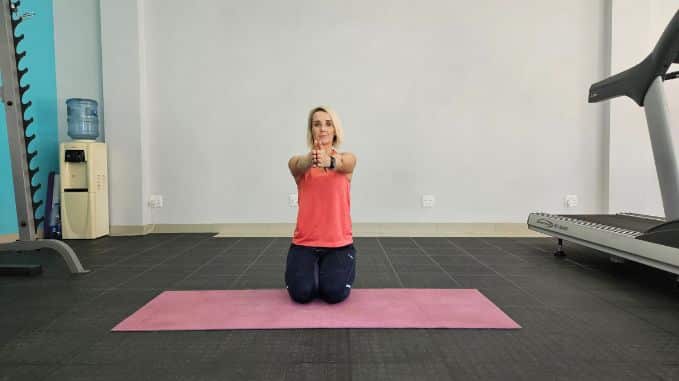 |
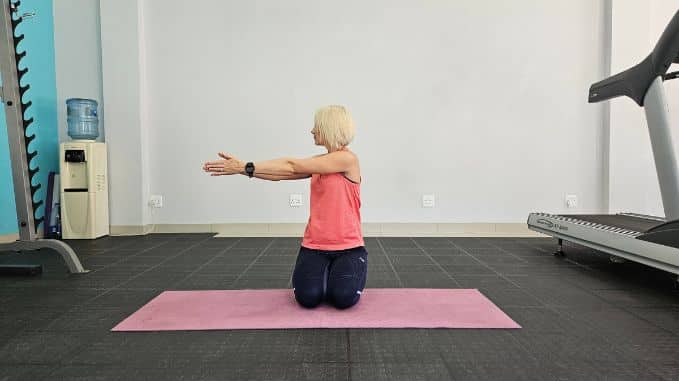 |
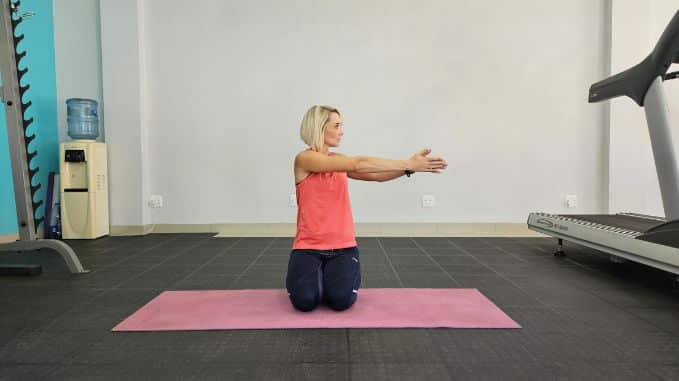 |
3. Diaphragm Stretch
Lie on your back with your knees bent and feet flat on the floor. Extend your hands overhead. Engage your abdominal muscles and relax your upper body. Hold this position as you inhale deeply through your nose and exhale through the mouth, forcing the air out as much as possible. Relax and repeat the movement for 3-5 repetitions.
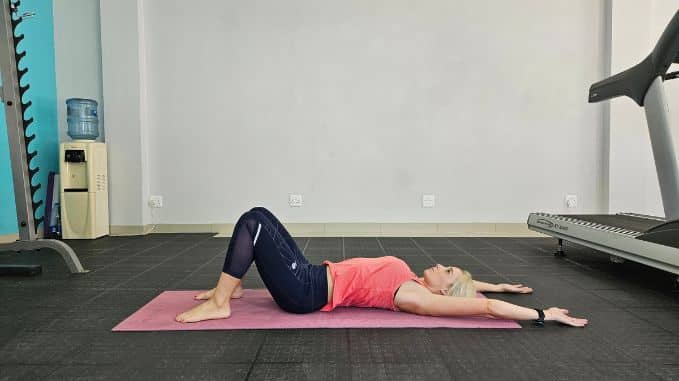
4. Diaphragmatic Breathing
Lie on your back with your knees bent and feet flat on the floor. Place your hands on your diaphragm, just below your rib cage. Engage your core and relax your upper body. Hold the position, take several deep belly breaths, in through your nose, and exhale through the mouth.
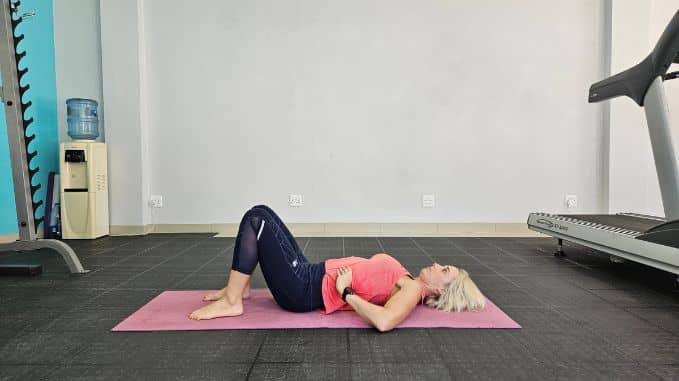
Note: Depending on your comfort level, you may do it seated or standing
Remember, Diaphragmatic Breathing is a skill that takes practice. Be patient with yourself as you incorporate these techniques into your daily life. You can use this tool to teach yourself to learn Diaphragmatic Breathing.
- Nasal Breathing – always check if you are nasal breathing, meaning breathing through your nose.
- Box Method – Imagine a box in front of you, and use it as a guide for breathing. Inhale for 4 seconds on the first side of the square, hold for 4 seconds on the second side, exhale for 4 seconds on the 3rd side, and finally hold for 4 seconds on the last side of the square. Repeat the cycle.
With time and consistency, diaphragmatic breathing will become second nature, and you'll reap the benefits. These exercises aim to reinforce diaphragmatic breathing vs chest breathing and their positive impact on physical and mental well-being.
Incorporating Diaphragmatic Breathing Into Your Daily Routine
Now that you understand diaphragmatic breathing techniques, it's time to incorporate them into your daily routine. Here are some tips to help you make diaphragmatic breathing a habit:
-
Set Reminders
Create reminders on your phone or computer to prompt you to take a few moments for diaphragmatic breathing throughout the day. These prompts serve as aids to keep you focused and make diaphragmatic breathing a regular part of your routine.
-
Start Small
Begin by incorporating diaphragmatic breathing into small moments throughout your day. Take a few deep breaths before getting out of bed in the morning or before starting a new task. As you become more comfortable with diaphragmatic breathing, you can slowly increase the time and frequency.
-
Find a Support System
Share your journey of incorporating diaphragmatic breathing with friends, family, or a support group. Having a support system can help keep you motivated and accountable.
-
Combine with Mindfulness Practices
Diaphragmatic breathing and mindfulness go hand in hand. Consider incorporating diaphragmatic breathing into your mindfulness or meditation practice. Combining these practices can deepen your relaxation and promote greater well-being.
Remember, the goal is to make diaphragmatic breathing a regular part of your life. Consistency is vital, so be patient with yourself as you establish this new habit.
How Diaphragmatic Breathing Can Reduce Stress and Anxiety
Diaphragmatic breathing has been proven to be an effective tool for reducing stress and anxiety. When we engage in diaphragmatic breathing, we activate the body's relaxation response, which counteracts the effects of the stress response.
By engaging in deliberate, deep breaths, we communicate with our body that we are safe and not in immediate danger. This helps to calm the nervous system, reduce heart rate, and lower the generation of stress hormones like cortisol.
In addition to the physiological benefits, diaphragmatic breathing also provides a mental anchor. When we focus on our breath, we bring our attention to the present moment, helping to quiet the mind and reduce racing thoughts. This can be particularly helpful for individuals having anxiety or panic attacks.
The Connection Between Diaphragmatic Breathing and Mindfulness
Diaphragmatic Breathing and mindfulness have a symbiotic relationship. Both approaches prioritize being in the present and nurturing an open, non-critical awareness of our thoughts, emotions, and physical sensations.
Diaphragmatic Breathing can serve as an anchor for mindfulness practice. By focusing on the sensation of our breath and the rise and fall of our belly, we bring our attention to the present moment. This can help quiet the mind and create a sense of calm and centeredness.
Likewise, mindfulness can enhance our diaphragmatic breathing practice. By bringing non-judgmental awareness to our breath and bodily sensations, we deepen our connection to the present moment and cultivate a greater sense of relaxation and well-being.
Conclusion: Choosing Diaphragmatic Breathing for Overall Well-Being
Diaphragmatic Breathing vs Chest Breathing: Breathing is essential to our existence, yet many overlook its importance. By choosing diaphragmatic breathing over chest breathing, we can tap into many benefits for our physical and mental well-being.
Diaphragmatic breathing reduces stress, improves lung function, and enhances mental clarity and deep relaxation. It's an easy yet powerful tool that can be incorporated into our daily routine with practice and consistency.
So take a moment to pause, take a deep belly breath, and exhale fully. Practice diaphragmatic breathing, embrace the power of diaphragmatic breathing, and experience a breath of fresh air for your mind, body, and soul. Your well-being will thank you.
If you seek a more serene meditation experience, delve into “Diaphragmatic Breathing vs. Chest Breathing: A Breath of Fresh Air,” and unravel the impact of mindful breath choices on your journey to tranquility. Check out our 5 Minute Meditation to Diffuse Holiday Stress.





